Are you here to find the perfect cold water aquarium fish? If so, you’ve come to the right place!
We understand that fishkeeping can seem like a daunting and complicated hobby for beginners, but the truth is that there are a lot of hardy fish species that are easy to care for. In some cases, you don’t even need a heater or other fancy equipment for your tank.
This is because not all fishes require warm water to survive. From guppies to the Asian Stone Catfish, we have rounded up the 12 best cold-water fishes you can get for your tank today.
If you don’t have time to read through everything, the best cold-water species to go for is actually the Bloodfin Tetra.
Or feel free to jump to the parts that interest you. Let’s go!
Table of Contents
Can You Keep Cold Water Fish in a Tank?
This is perhaps the defining question of today: is it possible to keep fish in a cold-water tank? The quick answer is a resounding yes!
Our top tip is to maintain a temperature of around 61 to 75F, which is the average temperature required for a lot of these cold-water species to thrive. It’s probably safe to say that most of them will do just fine at room temperature.
One thing to note is that you might want to ensure there is no draft or significant heat sources near your aquarium. This may include things like direct sun exposure and room heaters.
In fact, if you think that the water temperature is too hot, you can always install an aquarium chiller inside so your fishes can live happily…
Why Choose a Cold Water Aquarium Fish?
There are some obvious benefits to keeping a cold-water fish in your tank, especially if you are new to the fishkeeping world.
One, you don’t need a heater. This is a way to save both money and energy, as your little friend can withstand room temperature just fine!
Not only is this an excellent money-saving tip for hobbyists, but an aquarium without a heater can actually look more natural. You can fill the space with more plants, rocks, and interesting features without having a heater looking awkward and chunky.
A cold-water tank is also much easier to keep clean. This is because algae thrive in warmer temperatures, meaning a tropical aquarium can be a challenge in itself. Especially if you have lots of plants and vegetation in the tank.
Lastly, it can be safer for your fish if there are no heaters in the tank. If a power outage happens in your home, there is no need to panic because your fish will not get cold even if hours pass!
12 Best Cold Water Aquarium Fish Species
Here are some of the best cold-water fish species to get for your home tank:
1. Bloodfin Tetra
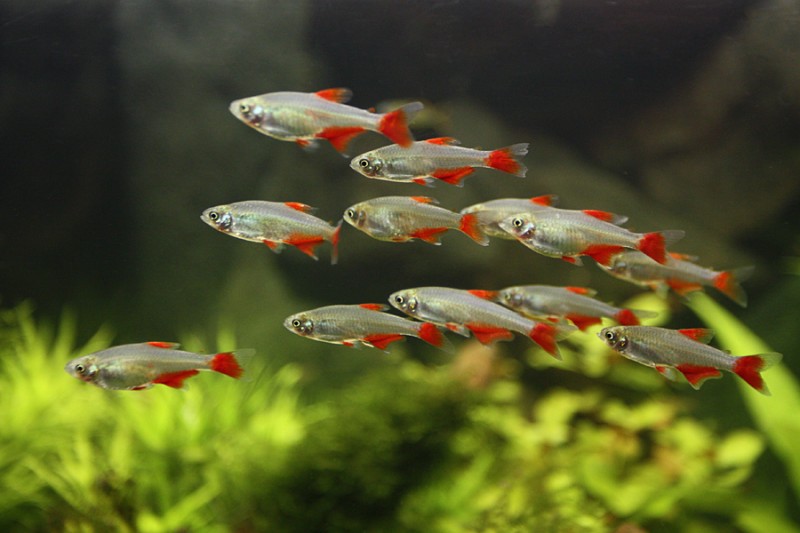
- Size: 2 inches
- Care difficulty: Easy
- Min. tank size: 15 gallons
The Bloodfin Tetra, scientifically known as the Aphyocharax anisitsi, hails from the waters of Brazil, Paraguay, and Argentina. They are an excellent schooling fish to add to an aquarium without a heater. With captivating blood-red fins, they will definitely liven up your aquascape!
Bloodfin Tetras are also very easy to care for, making them a great species for beginners and low-maintenance hobbyists. Their relatively small size also means you can keep them in a small tank without any problem.
Plus, setting up a home for these fishes is very simple. They’re hardy and can survive in cold water, a wide range of pH, and almost any style of tank. Not to mention that they are quite long-lived with a lifespan of more than five years.
We recommend keeping these surface dwellers in a group of at least six, which will give them a higher chance of thriving.
2. Gold Barb

- Size: 3 inches
- Care difficulty: Easy
- Min. tank size: 15 gallons
The Gold Barb (Barbodes semifasciolatus) is a favorite for many beginner tank owners for a reason. Sometimes also called Chinese Barb Fish, they are a schooling fish that are best kept in groups of 8 or more.
They are truly a wonderful cold water aquarium fish that you should consider.
Their natural color is greenish, but Gold Barbs sold for aquariums have developed a stunning golden color with red-hued fins and eyes, thanks to breeding. You may even be able to find the albino version in some stores!
Overall, their bright color and vibrant look can enliven even the dullest aquarium. They are quite mellow and peaceful so you can easily pair them with a lot of other species.
One thing to note is that because Gold Barbs like to be kept in schools, it can be best to house them in a medium-sized tank of at least 15 gallons. This should be even more if you have another fish species with them!
Rosy Barb
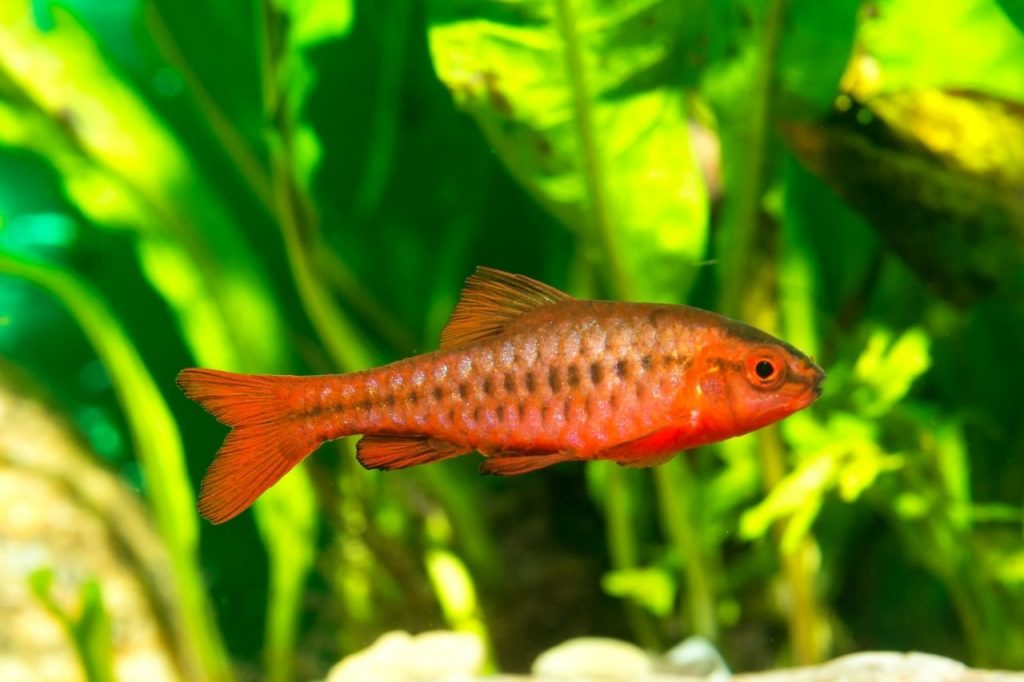
- Size: 6 inches
- Care difficulty: Medium
- Min. tank size: 30 gallons
Another barb species that does really well in a cold water tank is the Rosy Barb. Just as its name suggests, this fish has a striking and attractive red color, which might be something you’re looking for to jazz up your tank.
Additionally, they have graceful fins and reflective scales. Their eye-catching appearance is the main reason for their popular demand as it can easily bring a new dynamic to their home.
Rosy Barbs is a peaceful omnivorous species that will thrive in an unheated aquarium, making them a fantastic cold water aquarium fish. Their hardy and peaceful nature also make them an ideal choice for a community tank.
Although low maintenance, they can grow quite large in size and are very social, so your best bet is to keep them in a large tank. Pick them up as a school of at least 10 fishes!
White Cloud Mountain Minnow
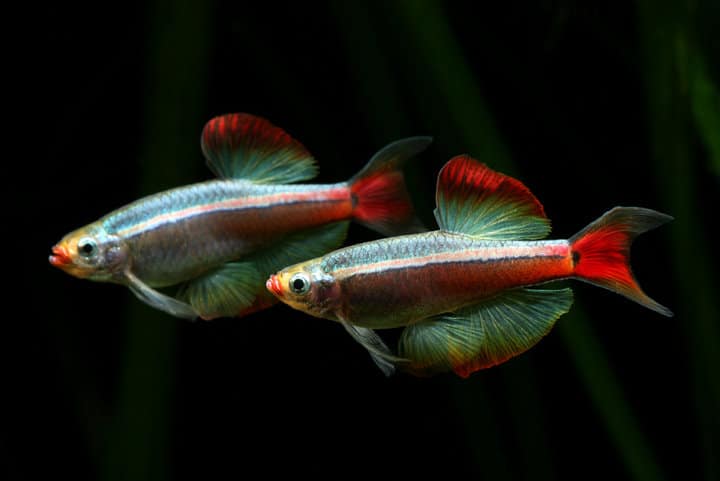
- Size: 1.5 inches
- Care difficulty: Easy
- Min. tank size: 10 gallons
The White Cloud Mountain Minnow lives in freshwater and can survive in waters with a colder temperature. They’re one of the smaller-sized fishes, which means they’re great if you have a limited tank size.
In terms of look, many compare them to the Neon Tetra as they have a dart-shaped body with snouts and a streamlined silhouette. You can find a gold-colored variant too if you want something even more striking.
Relatively peaceful and hardy, this is also a suitable species for community tanks. With that said, it’s probably best to keep them with other peaceful fishes too.
White Cloud Mountain Minnows got their name from their native habitat, which is the White Cloud Mountain in China.
Buenos Aires Tetra
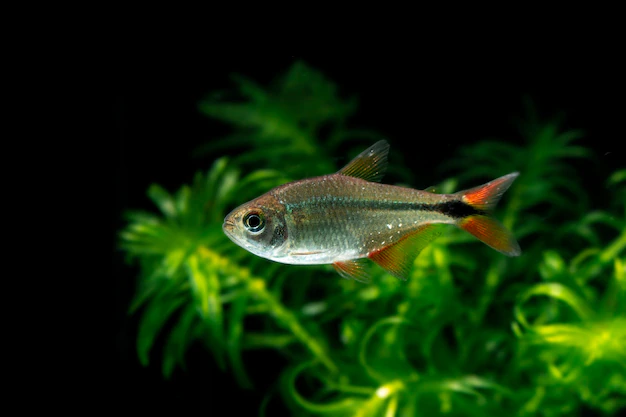
- Size: 2.75 inches
- Care difficulty: Easy
- Min. tank size: 30 gallons
Hemigrammus caudovittatus, more commonly known as the Buenos Aires Tetra, is native to Argentinian waters and is one of the larger species of tetras. They can grow up to three inches as an adult.
We think they are an excellent addition to any tank because of their silvery bodies with a narrow blue line. There is also a diamond marking near their tail, which makes for a unique appearance.
It’s not hard to find this fish in any local shop, whereas their ability to tolerate mid-60s temperature makes them relatively easy to care for. They are active and like to swim in schools, so we highly suggest keeping them in a larger aquarium!
While Buenos Aires Tetras can do great in a community tank, note that they love to nibble on live plants. These tetras also can jump from the water, so make sure to cover your tank.
Bristlenose Pleco

- Size: 5 inches
- Care difficulty: Medium
- Min. tank size: 15 gallons
If you’re looking for a hardy fish species for your freshwater tank, the Bristlenose Pleco may be the answer! Although their average lifespan is around five years, there have been cases where this fish reaches 12 years of age. Pretty impressive, right?
They are quite a unique fish that can eat algae and is perfect for unheated tanks. As a vegetarian, you can place some driftwood for them to nibble on throughout the day. Although it’s important to supplement this with some wafers and veggie feeds.
These bottom dwellers have a distinctive bushy nose on their snouts, which will develop once they hit around 6 months. They’re mostly dark-colored and have a large dorsal fin on top of their bodies.
While they can tolerate waters of around 60F, remember that the Bristlenose Pleco doesn’t tolerate extreme water changes well. Just be mindful of this!
Guppy
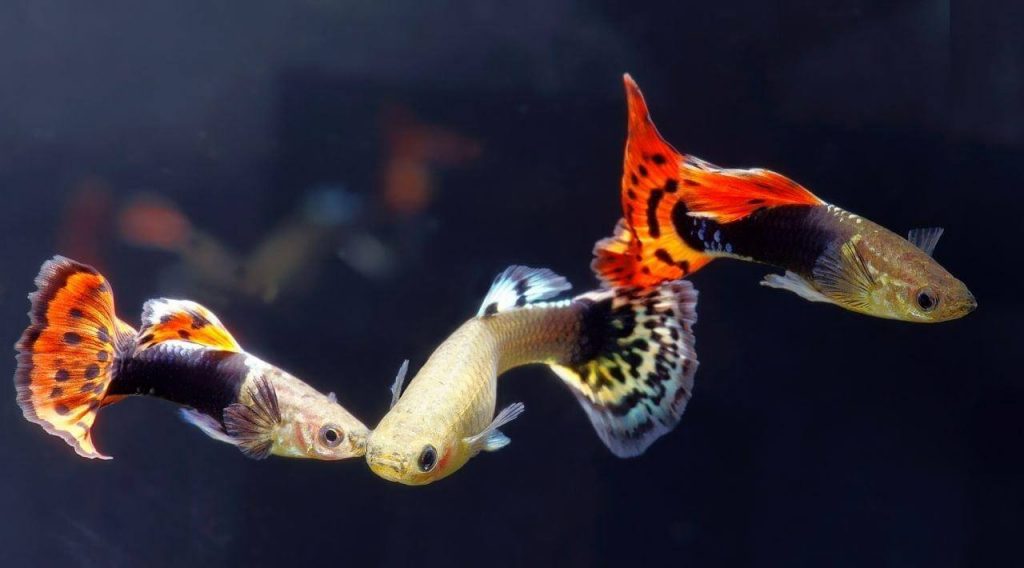
- Size: 1.5-2.5 inches
- Care difficulty: Easy
- Min. tank size: 10 gallons
As fishkeeping continues to grow in popularity as an interesting hobby and favorite pastime, many aquarium species are getting more and more attention. Among those include guppies.
Due to their easy maintenance and natural hardiness, guppies are especially popular among beginner hobbyists. They are a staple of many aquariums and have signature elongated bodies with tons of color variations.
As an easygoing species, you can safely keep them with most other fish species, although we recommend choosing similar fishes like mollies and neon tetras.
Hailing from Northeast South America, guppies are omnivores that can eat a wide variety of things. Your best bet would be pellets and frozen veggies.
When keeping guppies, we recommend separating the male and female fishes so you can prevent a population boom. This is because they breed really easily and quickly.
Dojo Loach
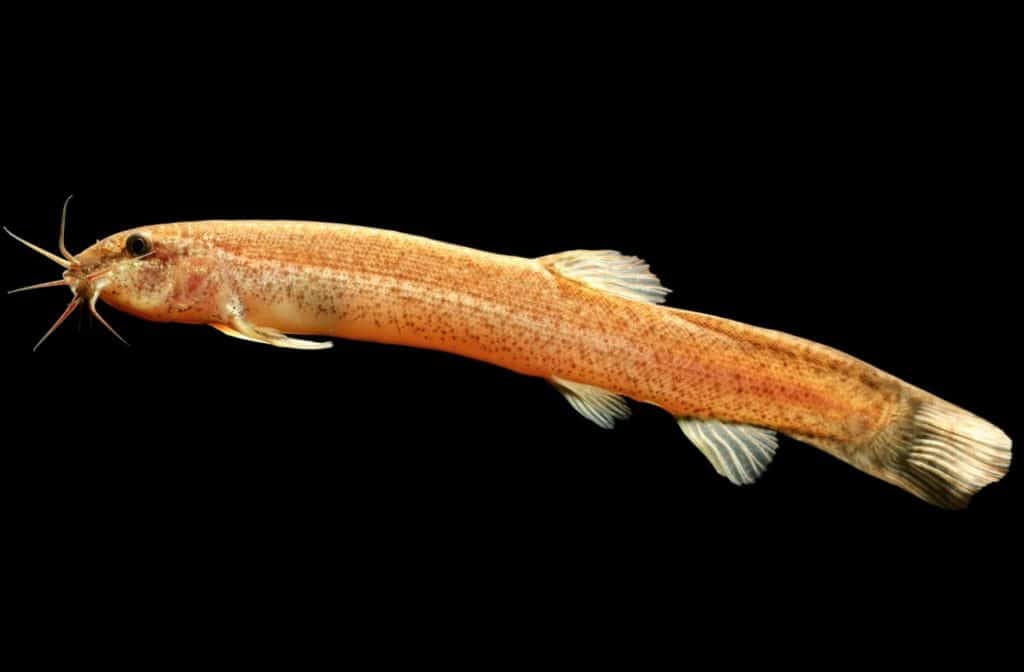
- Size: 6 inches
- Care difficulty: Easy
- Min. tank size: 55 gallons
The Dojo Loach (also Weather Loach) is a fantastic and fascinating fish to have in any aquarium. They can thrive in colder waters of as low as 50F, which means you don’t have to worry about installing a heater for them.
We love their unique, elongated bodies that often come in a muted olive color. You can also keep them alone as they’re not a schooling species.
While Dojo Loaches are easy to care for, they can grow up to 12 inches as an adult. This means it’s essential for their tank to be large enough for them to swim around and grow comfortably.
They have a peaceful temperament and can be a friendly tankmates for many other species. However, Dojo Loaches like to eat eggs, so be careful not to house them with any breeding fish!
Rainbow Shiner

- Size: 3 inches
- Care difficulty: Medium
- Min. tank size: 20 gallons
Rainbow Shiners can tolerate water temperatures of around 55 to 75F. Although not the most popular choice for aquariums, watching their sleek bodies dart through the tank can be a marvelous sight!
This fish species is native to the United States and has a vivid purple and pink spangling, which is the main appeal for many tank owners. Their torpedo-shaped bodies can reach up to 3 inches as an adult.
Moreover, we recommend keeping Rainbow Shiners as a group of six or more. Note that their typical lifespan is only between 1.5 to 2 years, which could be why many people prefer to choose other more long-lived fishes.
In terms of temperament, this fish is relatively docile. It is probably best for you to hose them with other species that are also peaceful to avoid any conflicts and accidents.
Endler’s Livebearer

- Size: 1.8 inches
- Care difficulty: Easy
- Min. tank size: 10 gallons
The Endler’s Livebearer can be a brilliant option for aquariums that don’t have a heater. While they aren’t specifically a cold-water species, they can thrive in an unheated tank if your home already has a warm temperature.
This fish looks very much like guppies but is even smaller as they usually grow to just around 1.8 inches in size. Many people prize them for their colorful appearance and low maintenance, which is great for beginners!
Since they are also pretty small, you don’t need the largest tank to house these lovely fishes. And since their natural habitat has plenty of algae and vegetation, you should try adding some live plants to their home as well.
In addition, Endler’s Livebearers can be quite active and agile, so it’s best if you keep a lid on your aquarium. This is a great way to ensure that they don’t jump out of the water.
Sunset Variatus
- Size: 2.5 inches
- Care difficulty: Medium
- Min. tank size: 15 gallons
Sunset Variatus is a livebearer species that can also thrive in cold water and is surprisingly easy to take care of. If you’re looking for a fish that will immediately enhance and enliven your aquarium, then this is it.
Their beautiful red and yellow colors actually mimic the sunset sky, hence their name. Indeed, you can stare at them swimming around in a tank for hours and not feel bored!
Despite a tolerance of different water temperatures, this species will thrive at a higher pH level. They are also very peaceful and can get along with various tankmates.
Native to water bodies in southern Mexico, they love aquariums with dense vegetation as they are herbivores. The good news is that you can keep them either in pairs or groups, which gives you flexibility in terms of how you want to populate your tank.
Asian Stone Catfish

- Size: 1.25 inches
- Care difficulty: Easy
- Min. tank size: 10 gallons
Last but not least, we have the Asian Stone Catfish (Hara jerdoni). They hail from rivers in South Asia, mainly northeastern India and Bangladesh, and is an excellent but underrated fish species in the aquarium trade.
They are tough, docile, and very low maintenance. Their gray bodies sport attractive red stripes and white or transparent bellies, which can look quite stunning in a home aquarium.
These semi-nocturnal bottom dwellers are extremely small in size, so you can easily keep them in a smaller tank with no problem. But try to provide a decent number of rocks and hiding spots as they are shy.
Their small size is also one of the main reasons why people love them, as they can look quite cute darting around the tank!
Moreover, the Asian stone catfish has a long lifespan of around 5 to 10 years. If you care for them well and ensure the most optimal living conditions, this fish can keep you company for a long while indeed.
Time to Pick Your Cold Water Aquarium Fish!
At the end of the day, the choice is all yours and you should only pick the fish species that you think will suit your needs the most. Some are more popular while others are lesser-known.
There are plenty of fishes that can live in cold water so there’s no need to provide a heater or keep monitoring the temperature.
Think about how easy they are to care for, your experience, the minimum tank size needed, and whether you have the space to accommodate them.
All in all, we do believe that a cold-water tank can be a great stepping stone for beginners. This is also the perfect option for those wanting to save some money and create a more natural-looking aquascape.
We hope this article has helped you pick the best cold water aquarium fish for your tank.
What do you think of our list?
Did we miss any great species that thrive in cold water?
Let us know in the comments below!






